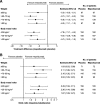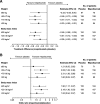Mepolizumab reduces exacerbations in patients with severe eosinophilic asthma, irrespective of body weight/body mass index: meta-analysis of MENSA and MUSCA
- PMID: 31362741
- PMCID: PMC6664536
- DOI: 10.1186/s12931-019-1134-7
Mepolizumab reduces exacerbations in patients with severe eosinophilic asthma, irrespective of body weight/body mass index: meta-analysis of MENSA and MUSCA
Abstract
Background: We assessed the efficacy of the licensed mepolizumab dose (100 mg subcutaneously [SC]) in patients with severe eosinophilic asthma according to body weight/body mass index (BMI).
Methods: This was a post hoc individual patient-level meta-analysis of data from the Phase 3 studies MENSA (MEA115588/NCT01691521) and MUSCA (200862/NCT02281318). Patients aged ≥12 years with severe eosinophilic asthma and a history of exacerbations were randomised to 4-weekly placebo, mepolizumab 75 mg intravenously (IV) or 100 mg SC (MENSA) or placebo or mepolizumab 100 mg SC (MUSCA) for 32 (MENSA) or 24 (MUSCA) weeks. The primary endpoint was the annual rate of clinically significant exacerbations; other outcomes included the proportion of patients with no exacerbations, lung function, St George's Respiratory Questionnaire (SGRQ) and Asthma Control Questionnaire-5 (ACQ-5) scores and blood eosinophil counts. Analyses were performed by baseline body weight and BMI (≤60, > 60-75, > 75-90, > 90, < 100, ≥100 kg; ≤25, > 25-30, > 30, < 36, ≥36 kg/m2).
Results: Overall, 936 patients received placebo or mepolizumab 100 mg SC. Across all body weight/BMI categories, mepolizumab reduced the rate of clinically significant exacerbations by 49-70% versus placebo. Improvements with mepolizumab versus placebo were also seen in lung function in all body weight/BMI categories except > 90 kg; improvements in SGRQ and ACQ-5 scores were seen across all categories.
Conclusions: Mepolizumab 100 mg SC has consistent clinical benefits in patients with severe eosinophilic asthma across a range of body weights and BMIs. Data show that the fixed-dose regimen of mepolizumab is suitable, without the need for weight-based dosing.
Trial registration: This manuscript is a post hoc meta-analysis of data from the Phase 3 studies MENSA and MUSCA. ClinicalTrials.gov, NCT01691521 (MEA115588; MENSA). Registered September 24, 2012. ClinicalTrials.gov, NCT02281318 (200862; MUSCA). Registered November 3, 2014.
Keywords: Asthma; Asthma pharmacology; Body mass index; Body weight; Mepolizumab.
Conflict of interest statement
DJB, ESB, SWY and NK are employees of GSK and hold stocks/shares in GSK. FCA was an employee of GSK at the time of this analysis and holds stocks/shares in GSK. AP has received grants, personal fees and non-financial support and other from AstraZeneca, Teva, Mundipharma, GSK, Chiesi and Boehringer Ingelheim; has received personal fees and non-financial support from Novartis, Menarini and Zambon; and has received grants from Sanofi. CT has received fees from GSK, AstraZeneca, Novartis, Teva, Sanofi, Genzyme and Roche (consultancy, advisory boards) and was an investigator in trials involving GSK, AstraZeneca, Novartis, Sanofi, Roche and Boehringer Ingelheim.
Figures







Similar articles
-
Impact of baseline clinical asthma characteristics on the response to mepolizumab: a post hoc meta-analysis of two Phase III trials.Respir Res. 2021 Jun 22;22(1):184. doi: 10.1186/s12931-021-01767-z. Respir Res. 2021. PMID: 34158028 Free PMC article. Review.
-
Effect of mepolizumab in severe eosinophilic asthma according to omalizumab eligibility.Respir Med. 2019 Jul-Aug;154:69-75. doi: 10.1016/j.rmed.2019.06.004. Epub 2019 Jun 8. Respir Med. 2019. PMID: 31220806
-
Baseline blood eosinophil count as a predictor of treatment response to the licensed dose of mepolizumab in severe eosinophilic asthma.Respir Med. 2019 Nov;159:105806. doi: 10.1016/j.rmed.2019.105806. Epub 2019 Nov 3. Respir Med. 2019. PMID: 31751853
-
Mepolizumab improves clinical outcomes in patients with severe asthma and comorbid conditions.Respir Res. 2021 Jun 7;22(1):171. doi: 10.1186/s12931-021-01746-4. Respir Res. 2021. PMID: 34098955 Free PMC article. Review.
-
Impact of exacerbations on St George's Respiratory Questionnaire score in patients with severe asthma: post hoc analyses of two clinical trials and an observational study.J Asthma. 2020 Sep;57(9):1006-1016. doi: 10.1080/02770903.2019.1630640. Epub 2019 Jun 28. J Asthma. 2020. PMID: 31251094
Cited by
-
Real-life effectiveness of mepolizumab in patients with severe refractory eosinophilic asthma and multiple comorbidities.World Allergy Organ J. 2020 Sep 18;13(9):100462. doi: 10.1016/j.waojou.2020.100462. eCollection 2020 Sep. World Allergy Organ J. 2020. PMID: 32994855 Free PMC article.
-
Clinical characteristics and cytokine profiles of adult obese asthma with type2 inflammation.Sci Rep. 2023 Sep 8;13(1):14799. doi: 10.1038/s41598-023-41889-6. Sci Rep. 2023. PMID: 37684314 Free PMC article.
-
Obesity-related Asthma: A Pathobiology-based Overview of Existing and Emerging Treatment Approaches.Am J Respir Crit Care Med. 2024 Nov 15;210(10):1186-1200. doi: 10.1164/rccm.202406-1166SO. Am J Respir Crit Care Med. 2024. PMID: 39311907 Review.
-
Treating severe asthma: Targeting the IL-5 pathway.Clin Exp Allergy. 2021 Aug;51(8):992-1005. doi: 10.1111/cea.13885. Epub 2021 May 21. Clin Exp Allergy. 2021. PMID: 33887082 Free PMC article. Review.
-
Serum and urine eosinophil-derived neurotoxin (EDN) levels predict biologic response in severe asthma.World Allergy Organ J. 2025 Jan 9;18(1):100990. doi: 10.1016/j.waojou.2024.100990. eCollection 2025 Jan. World Allergy Organ J. 2025. PMID: 39896201 Free PMC article.
References
-
- Global asthma report. http://globalasthmareport.org/. Accessed 16 Oct 2018.
-
- Mepolizumab (NUCALA) US prescribing information. https://www.accessdata.fda.gov/drugsatfda_docs/label/2015/125526Orig1s00.... Accessed 4 Dec 2018.
-
- Mepolizumab (NUCALA) EU summary of product characteristics. https://www.ema.europa.eu/documents/product-information/nucala-epar-prod.... Accessed 4 Dec 2018.

